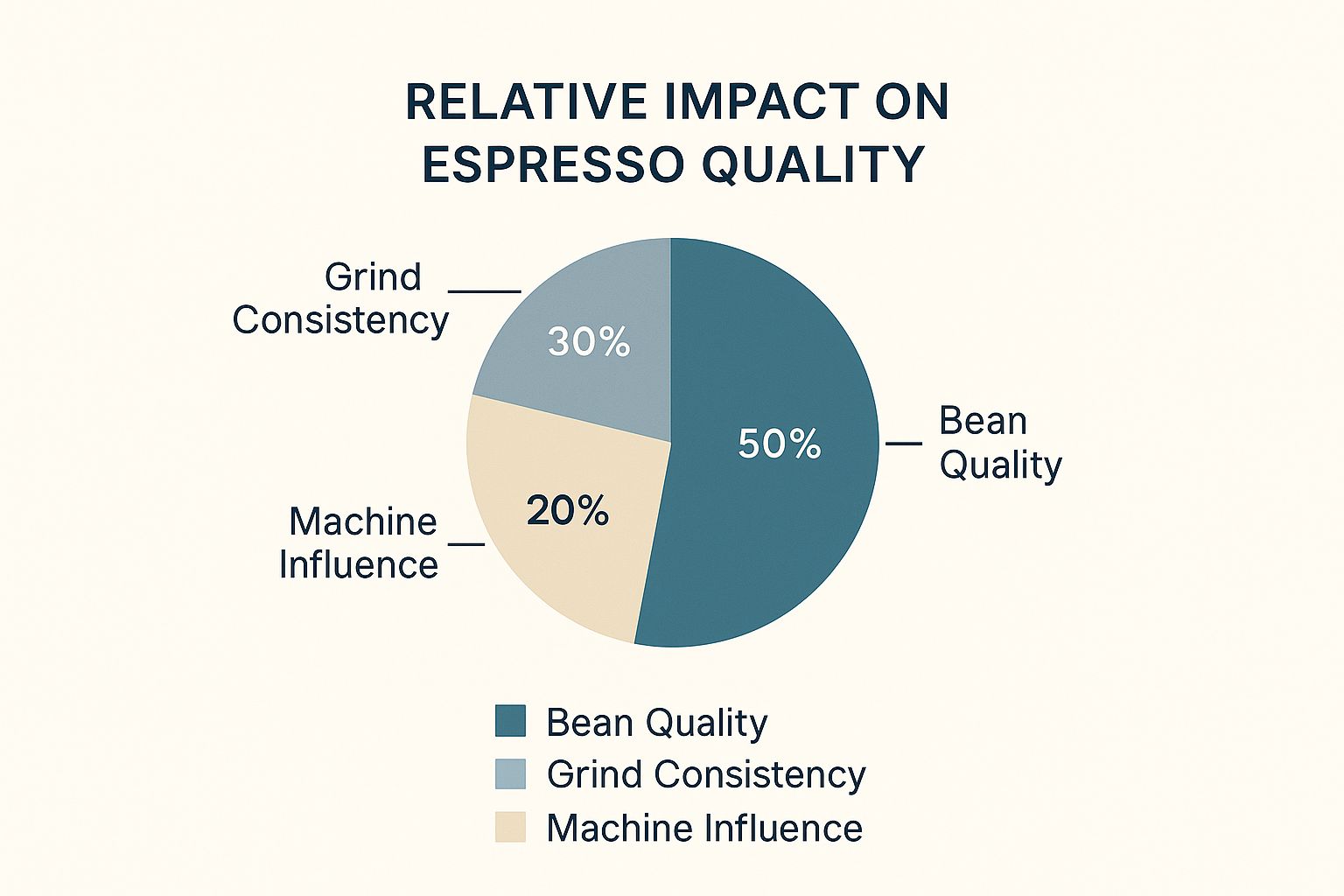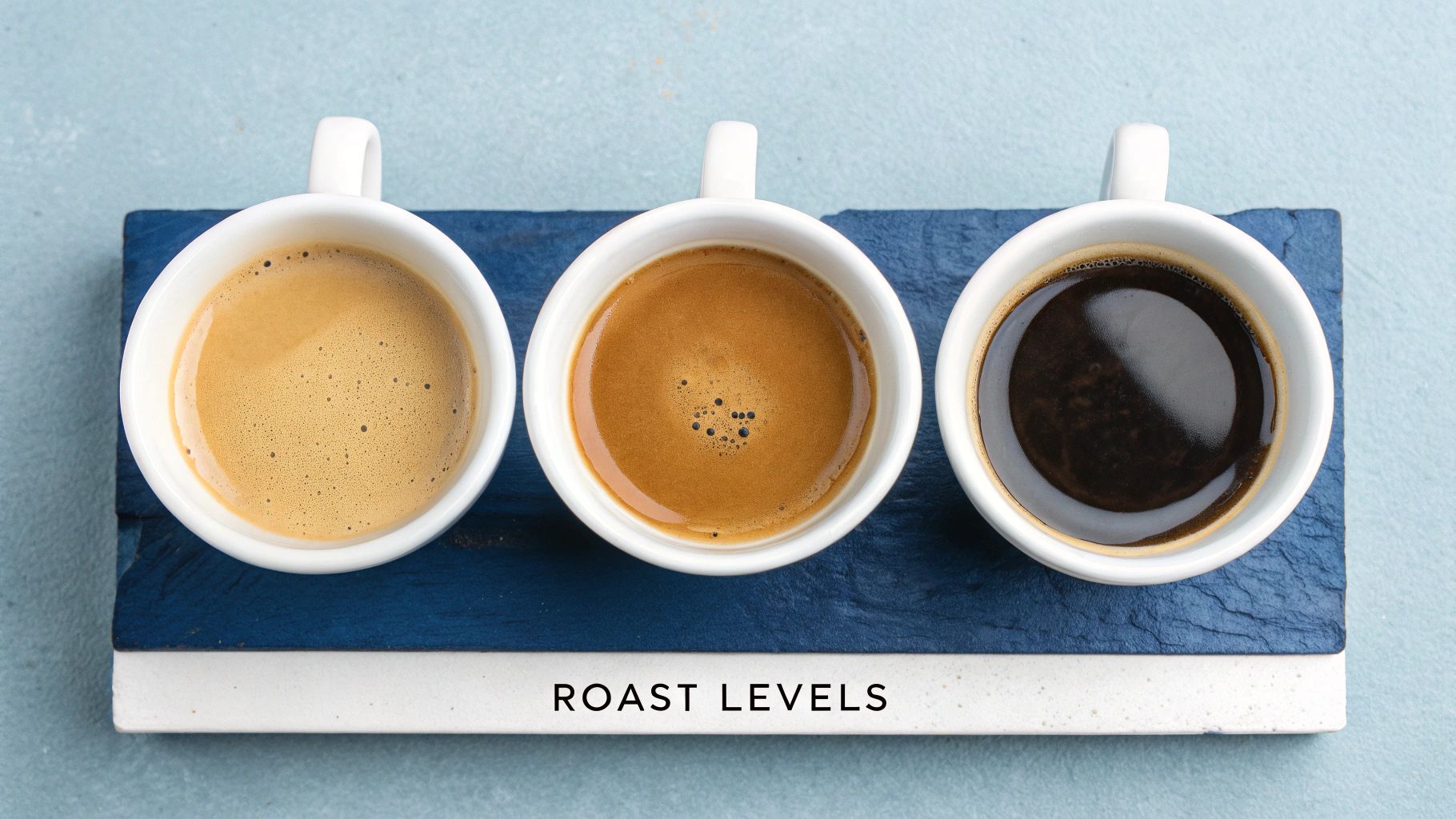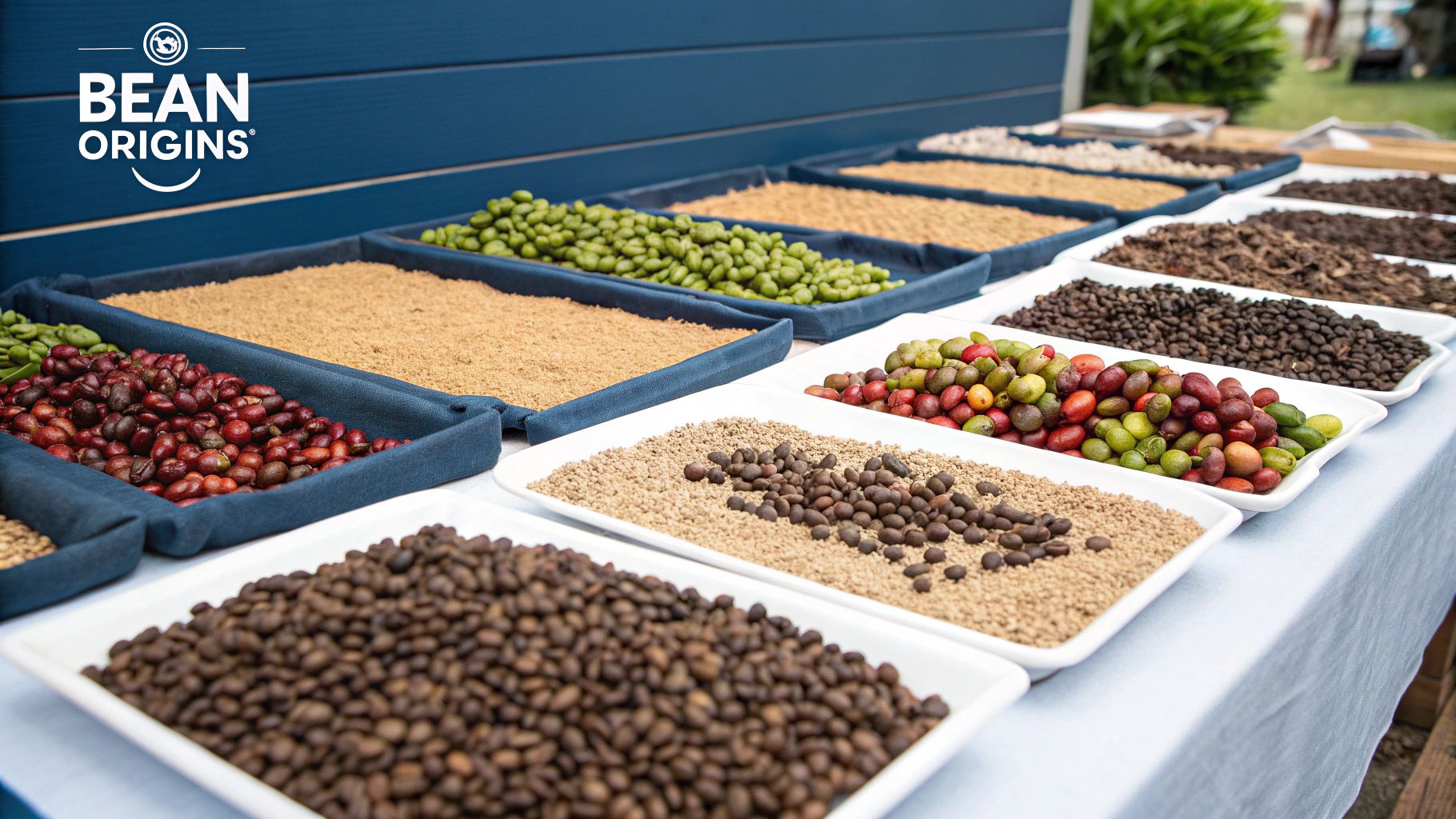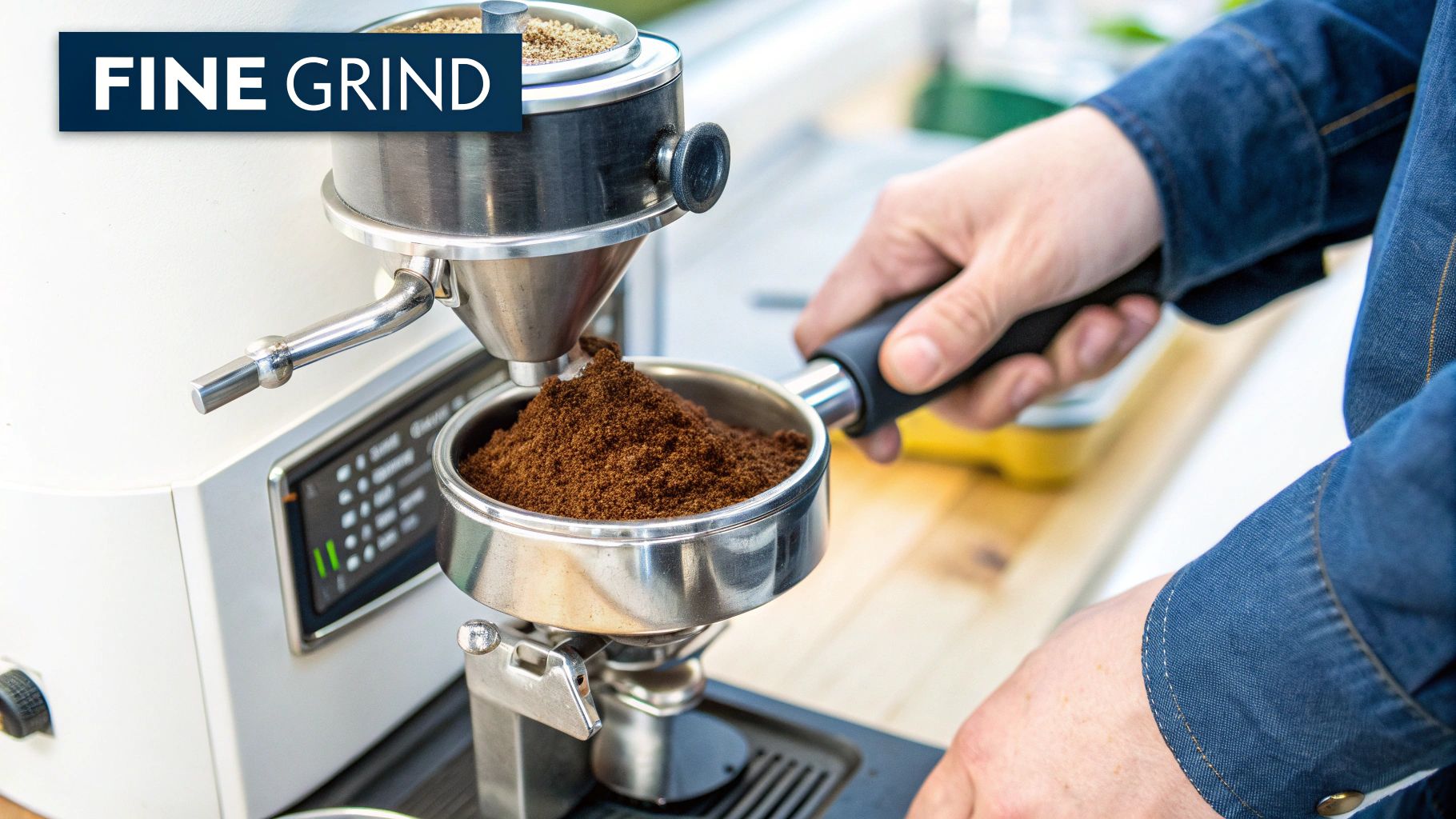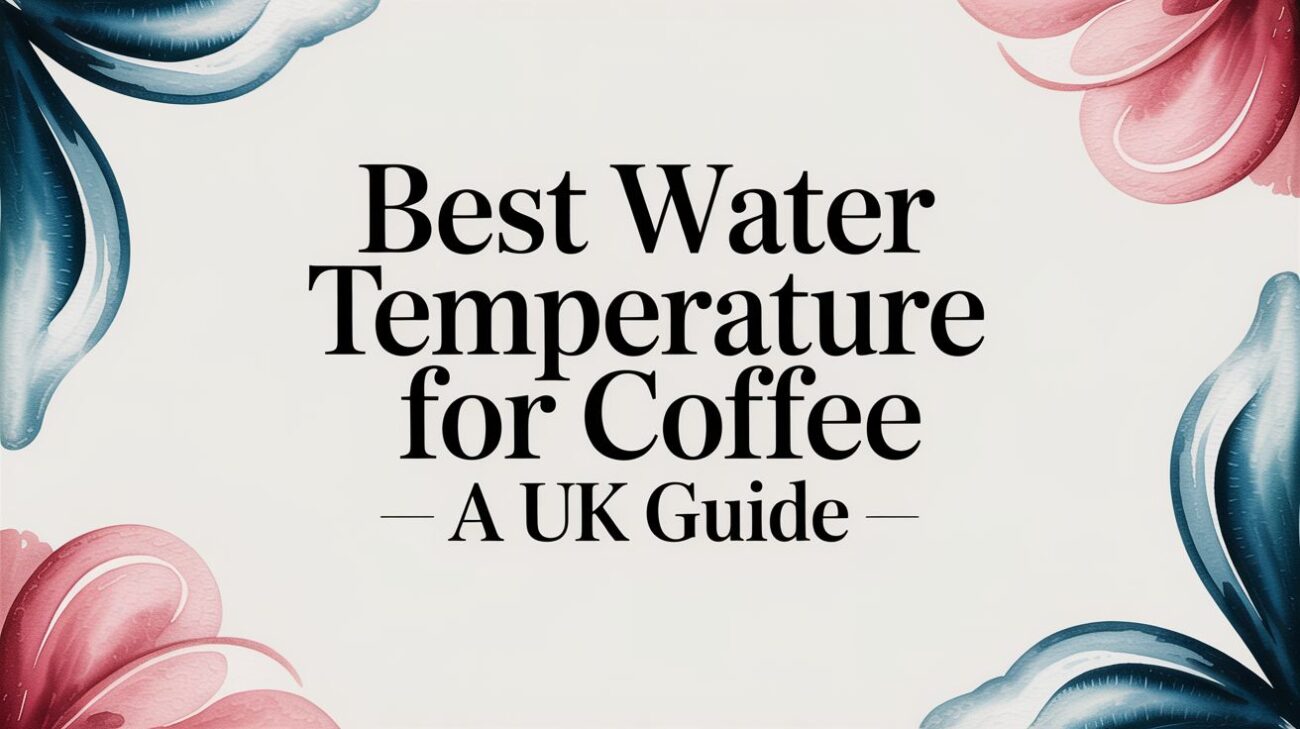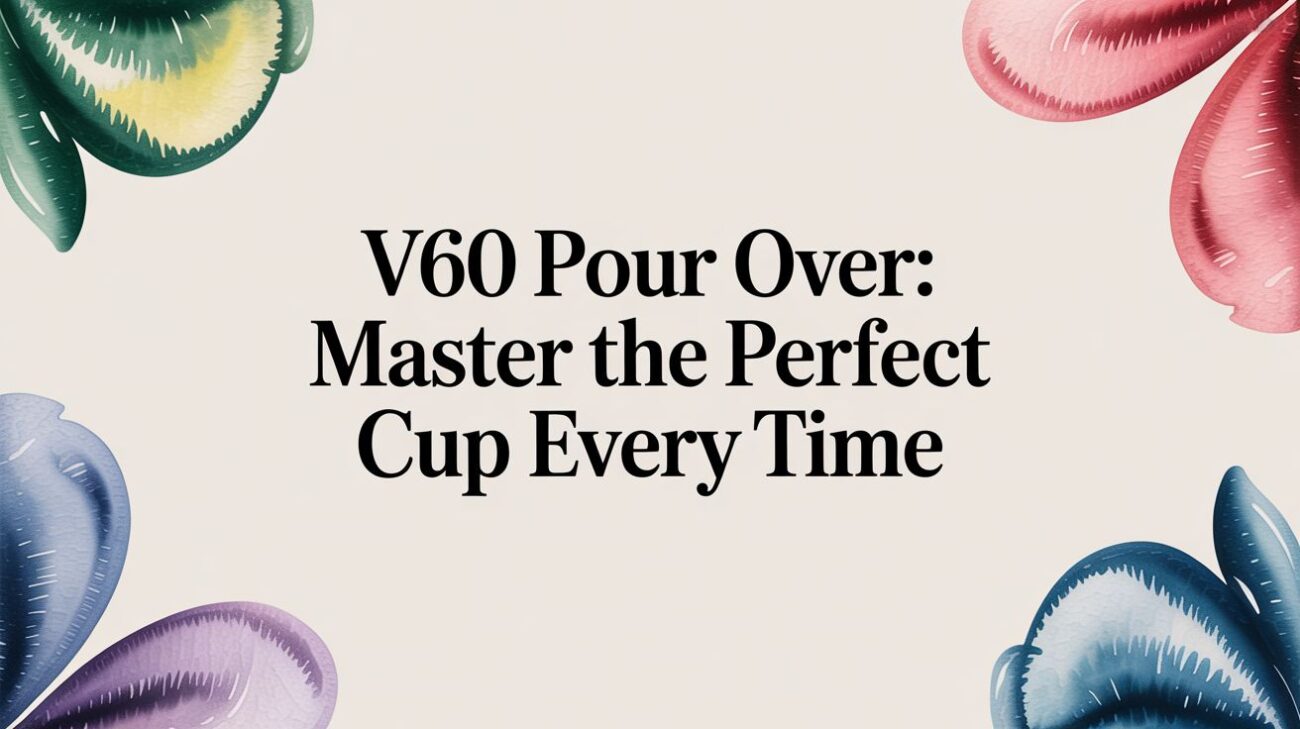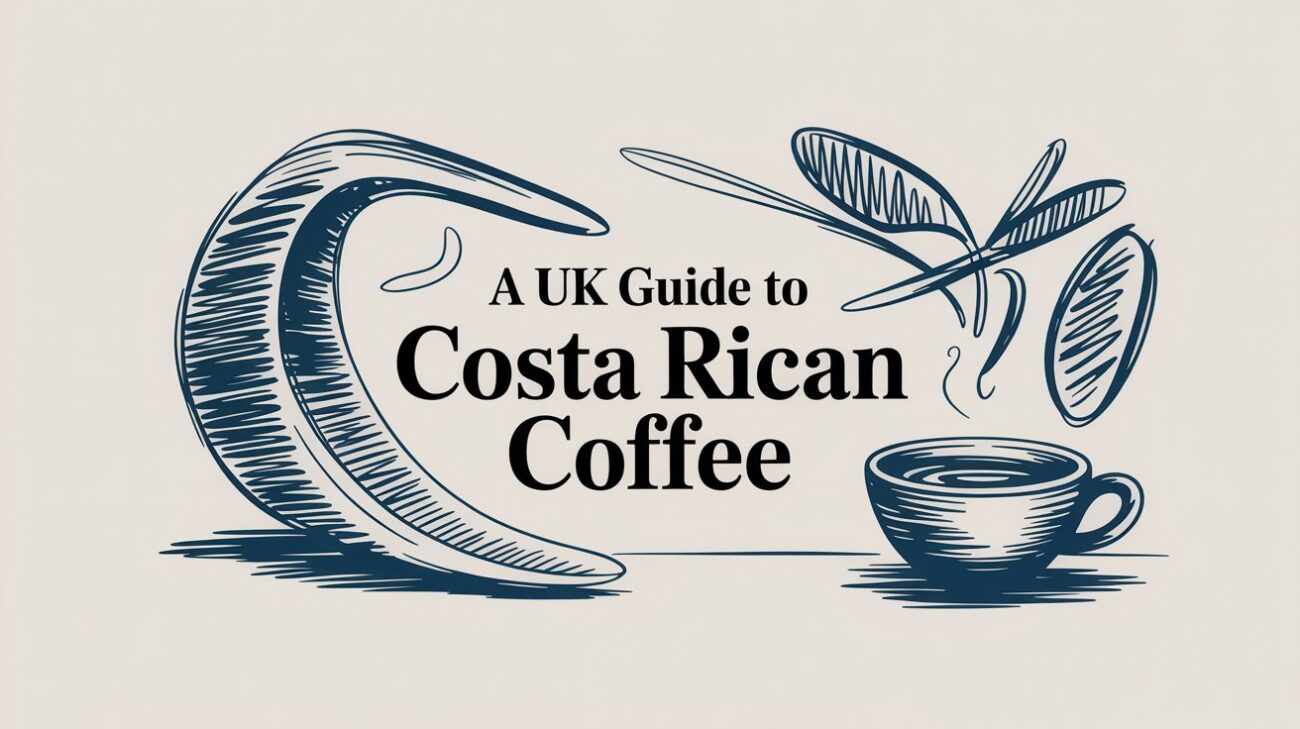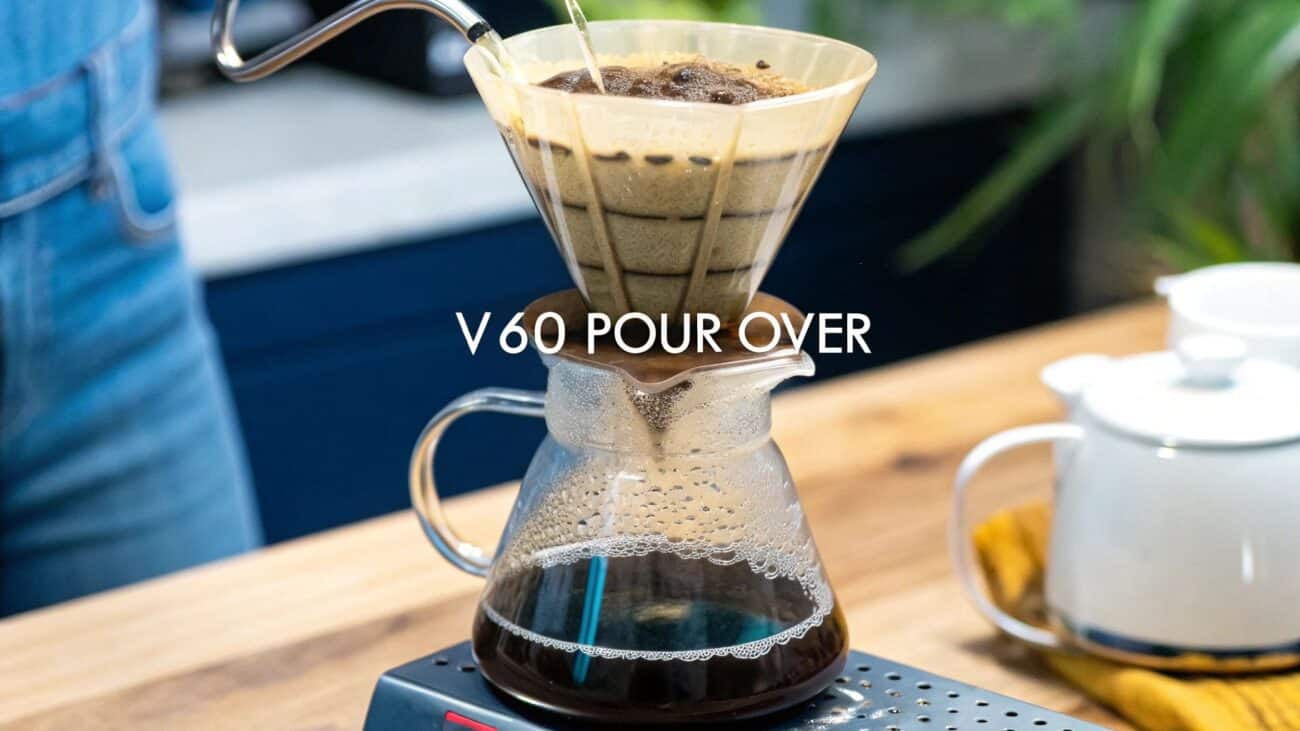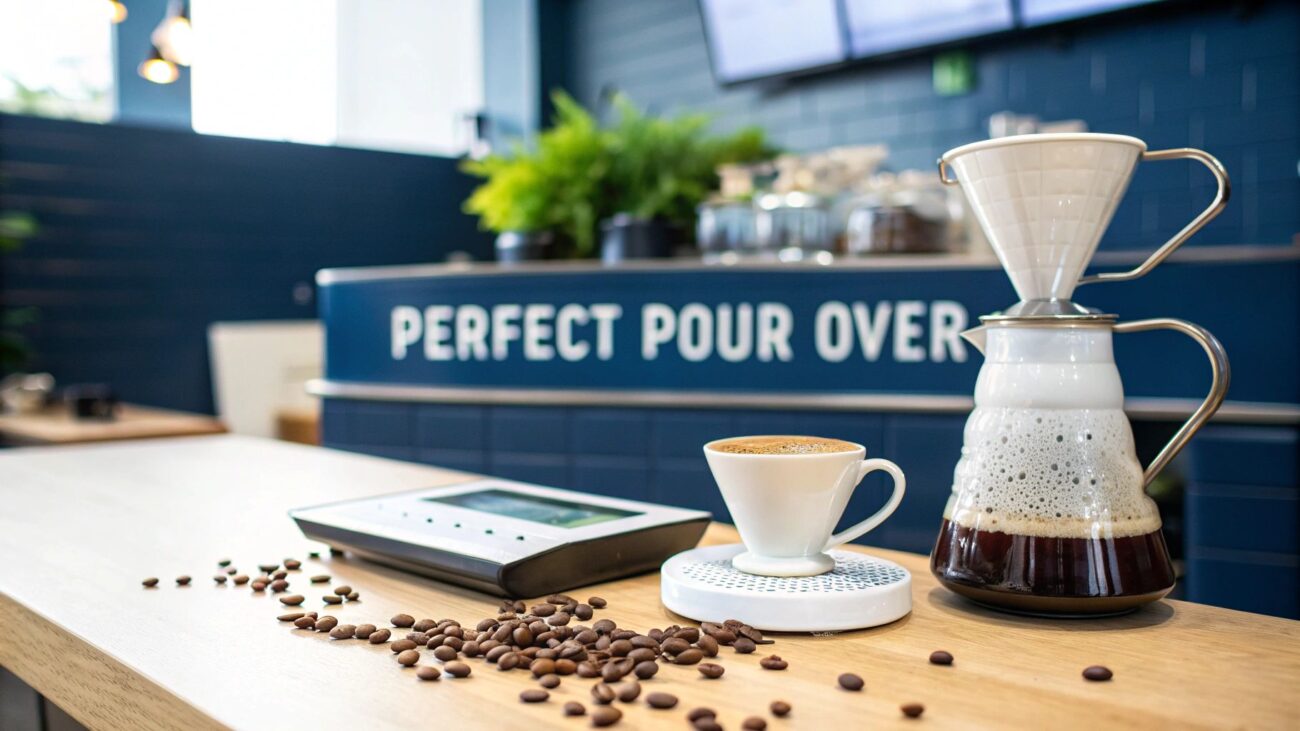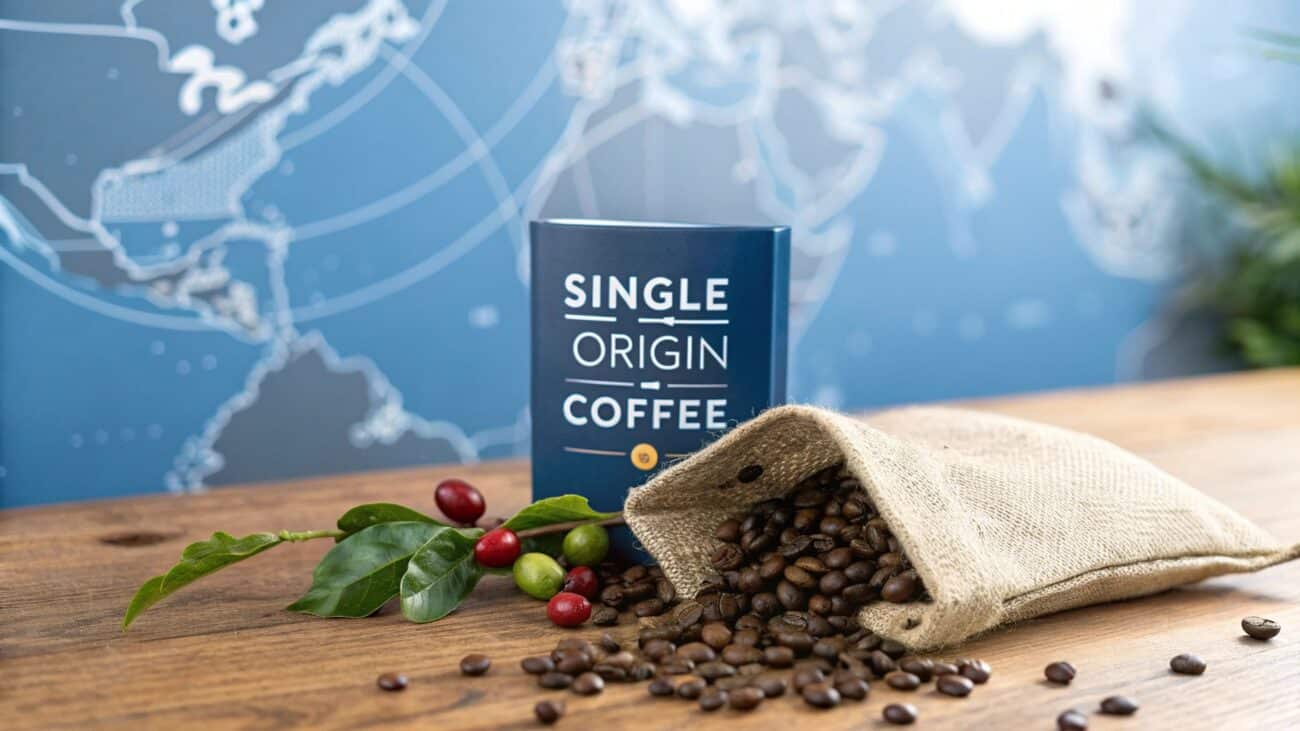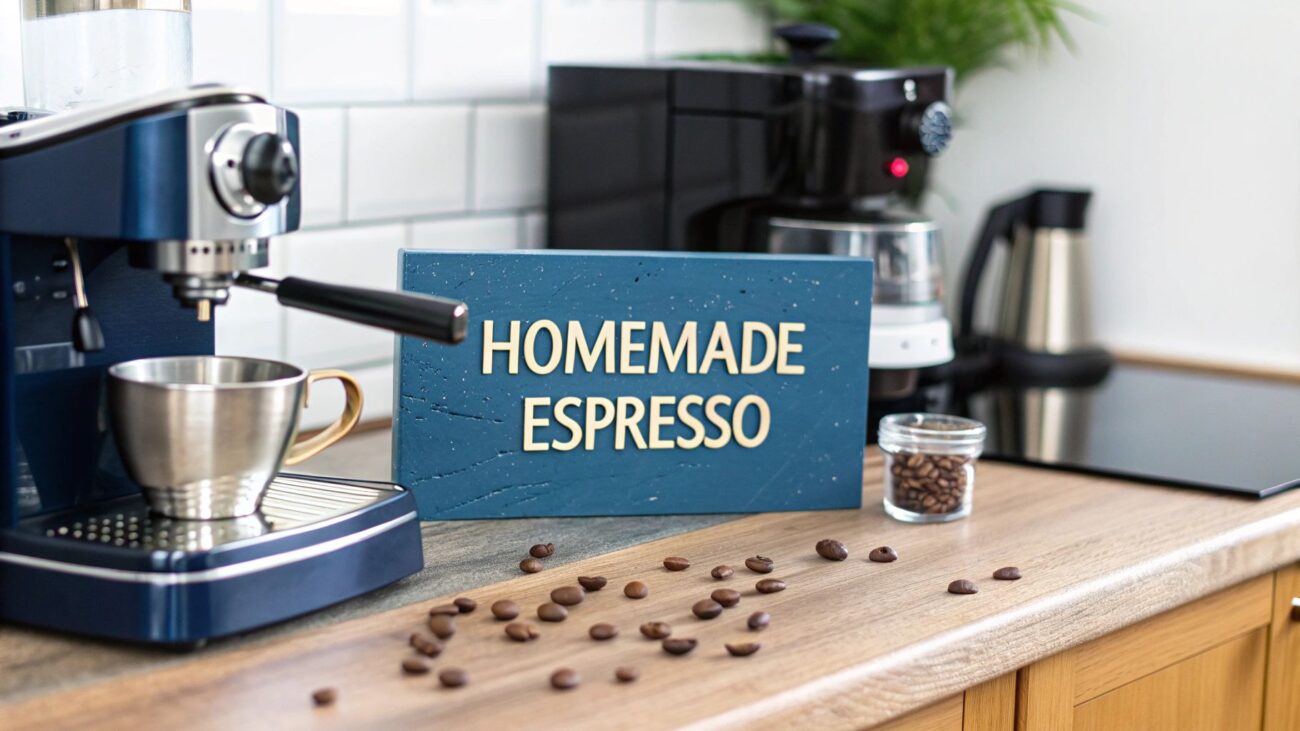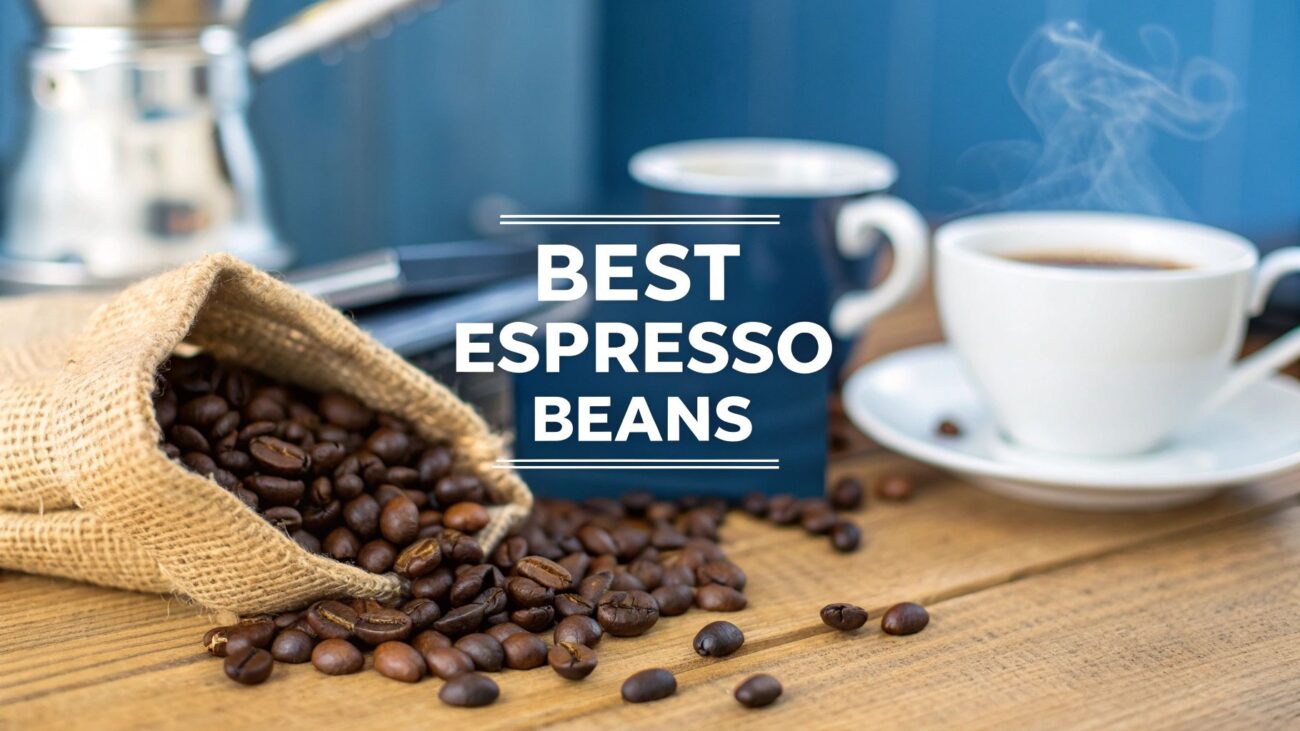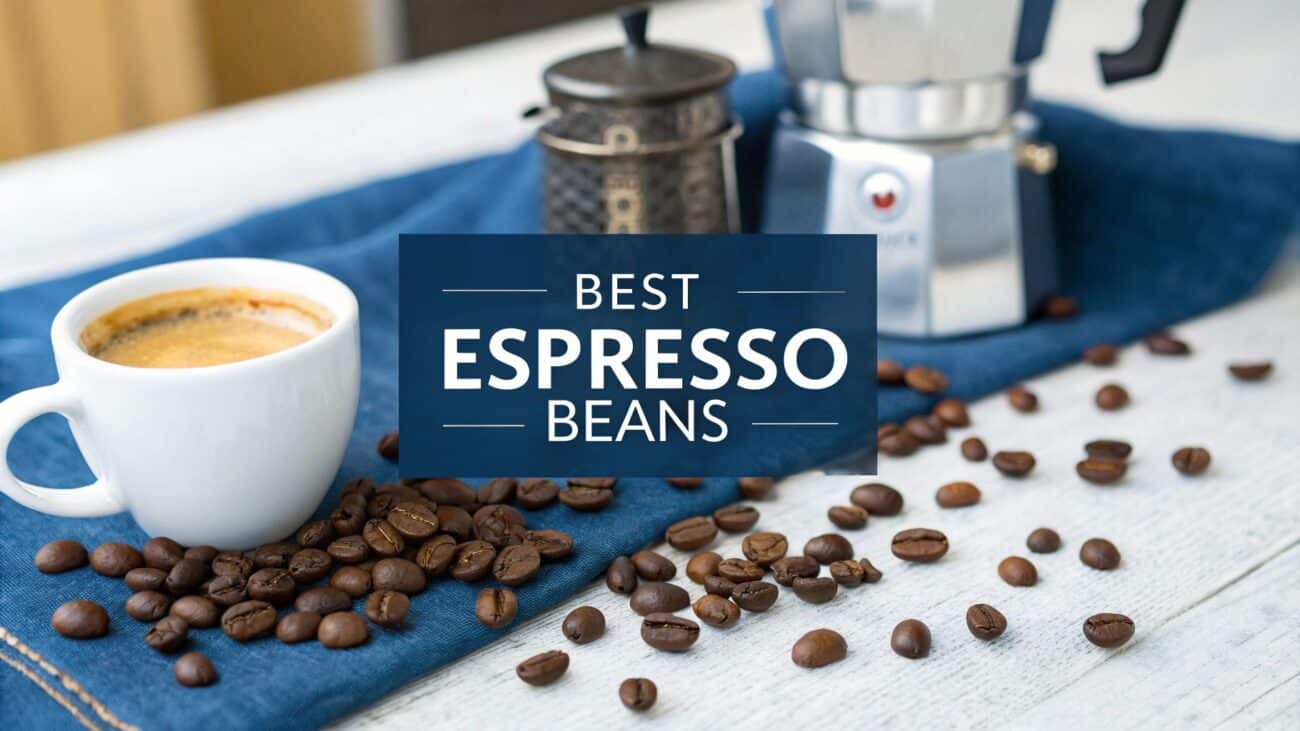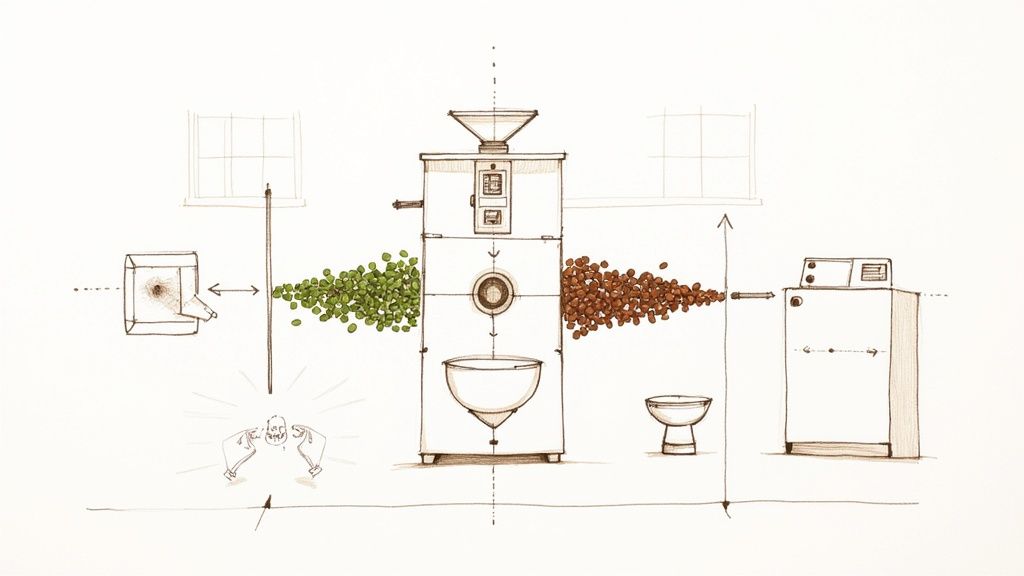Choosing Coffee Beans for Espresso Machines
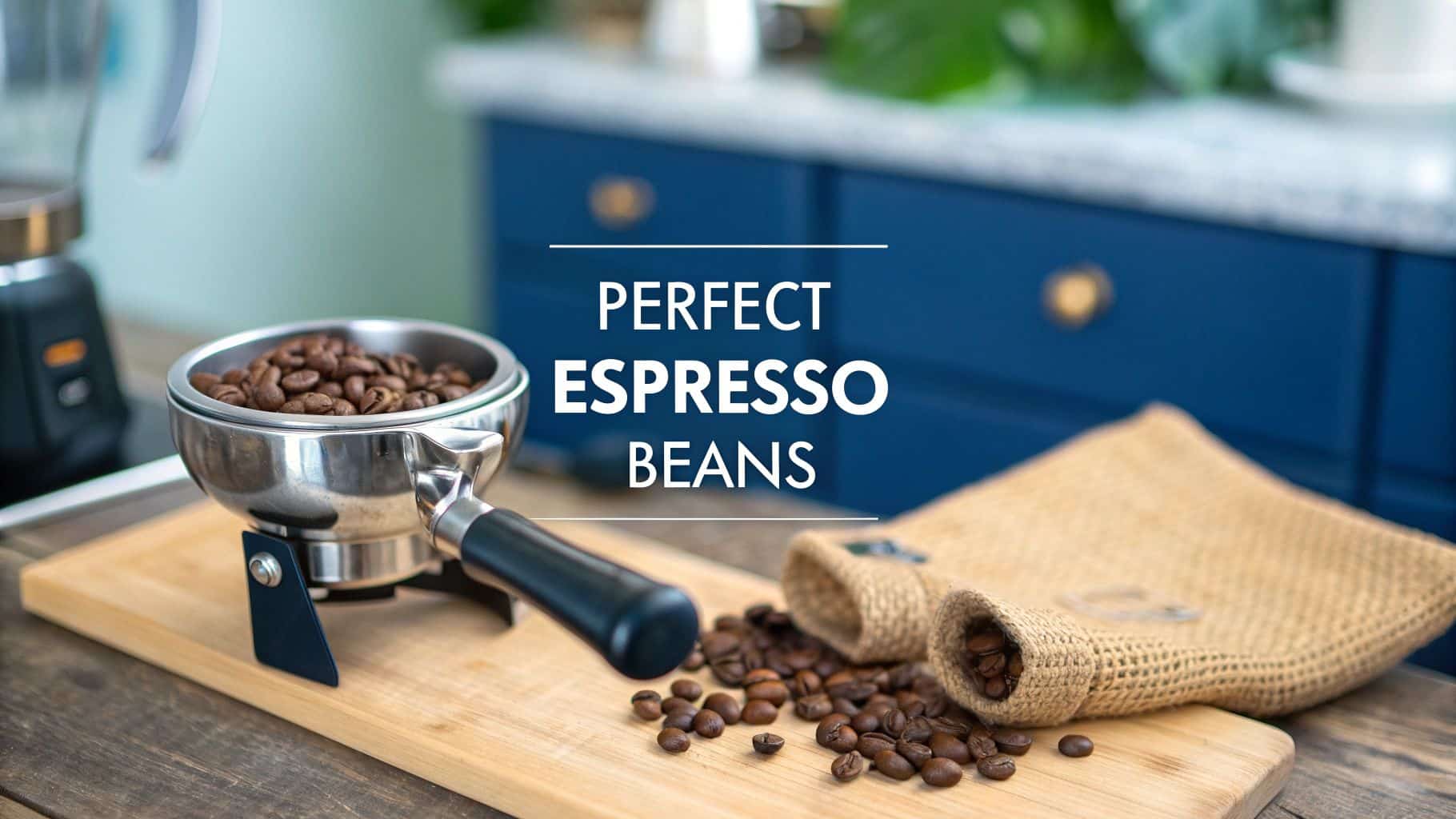
When you're chasing the perfect espresso, it’s easy to get fixated on that shiny new machine. But here's a little secret from those of us who live and breathe coffee: the real magic starts long before you press a single button. The best coffee beans for an espresso machine are typically medium to dark roasts, as this is where those rich, chocolatey flavours and full-bodied textures develop, giving you that classic, deeply satisfying shot. The quality of the bean itself is, without a doubt, the most important piece of the puzzle.
Why Your Choice of Coffee Bean Is Crucial
Think of it like cooking a gourmet meal. Even the most advanced, expensive oven in the world can't salvage a dish made with subpar ingredients. The exact same principle applies to your coffee. An espresso machine is just a tool, a powerful one at that, designed to use high pressure to pull all the flavour out of coffee grounds. If those beans are old, poorly grown, or badly roasted, the result will always be flat, sour, or bitter—no matter how impressive your machine is.
This little infographic breaks down what really makes a great espresso.
As you can see, the bean itself is responsible for a massive chunk of what you taste in the cup. That’s why getting this choice right is so fundamental.
The UK's Growing Passion for Quality Coffee
It’s no secret that the UK's love for high-quality, café-style coffee at home is booming. You can see it everywhere. This isn't just a feeling; the numbers back it up. The UK coffee machine market was valued at USD 268.6 million in 2022 and is on track to hit USD 425.2 million by 2030. This explosion in home brewing has sparked a real hunger for better beans, pushing people away from generic supermarket shelves and towards freshly roasted, speciality options. If you're curious, you can explore more about these market trends in the UK to see just how big this shift is.
The journey to exceptional espresso doesn't start with turning on a machine. It begins with the thoughtful selection of a coffee bean, chosen for its origin, roast profile, and freshness.
What This Guide Will Cover
Here at Seven Sisters Coffee Co., we're firm believers that everyone deserves a brilliant cup of coffee. It’s why our commitment to quality, freshness, and sustainable sourcing is at the core of everything we do. We’ve put this guide together to give you the confidence to pick the perfect beans for your espresso machine, turning your daily ritual into something truly special.
We’ll walk through everything you need to know:
- Roast Profiles: How light, medium, and dark roasts completely change the flavour.
- Bean Origins: Discovering how geography shapes the taste in your cup.
- Grind and Freshness: Why these two elements are non-negotiable for great espresso.
How Roast Levels Define Your Espresso Flavour
The journey from a raw, green coffee bean to the aromatic espresso in your cup hinges on one critical step: roasting. Think of it like toasting bread. A short time in the toaster gives you something light and golden where you can still taste the grain. Leave it longer, and it develops deep, caramelised flavours, becoming dark and bold.
Roasting is both an art and a science. It’s where a roaster carefully develops the sugars, acids, and oils inside the bean to craft a specific flavour profile. Understanding the difference between a light, medium, and dark roast is your key to finding the perfect coffee beans for your espresso machine and matching them to your taste.
The Classic Choice: Medium to Dark Roasts
For decades, the world of espresso has been built on medium and dark roasts, and for very good reason. Espresso is an intense, high-pressure brewing method that can easily amplify the bright, sharp acidity found in lighter roasts, sometimes leading to a shot that’s unpleasantly sour.
Medium and dark roasts, on the other hand, are developed for longer at higher temperatures. This extended roasting time is what makes them so well-suited for espresso:
- It tames acidity: The longer roast breaks down the bright chlorogenic acids, resulting in a smoother, more balanced cup.
- It develops sweetness: Sugars within the bean caramelise, creating those familiar rich notes of chocolate, nuts, and caramel we all love in a classic espresso.
- It builds a fuller body: As the bean’s structure becomes more porous, oils migrate to the surface. These oils give the shot a heavier, more viscous mouthfeel and help create a thick, stable crema.
That beautiful reddish-brown foam, the crema, is the hallmark of a great espresso shot. The oils and dissolved CO2 needed to create a rich, lasting crema are far more abundant in darker roasts. For a deep dive into how roasting shapes these characteristics, check out our guide to understanding different coffee roasting profiles.
The Rise of Light Roast Espresso
While tradition has long favoured darker profiles, a new wave of speciality cafés and coffee lovers are embracing the challenge of light roast espresso. It’s an approach that demands more precision but rewards you with a completely different sensory experience. Instead of deep, bass notes of chocolate, you get vibrant, high notes of fruit and florals.
A light roast preserves more of the bean's origin character—the unique flavours shaped by its altitude, soil, and processing method. A lightly roasted Ethiopian bean might give you an espresso bursting with blueberries or bergamot, while a Kenyan could explode with notes of blackcurrant. These shots are typically brighter, more acidic, and have a lighter body.
Pulling a great light roast shot is trickier. It often requires a finer grind, a longer extraction time, and sometimes a higher brew temperature to properly extract the flavours without tipping into sourness. The crema on a light roast is also usually thinner and fades more quickly.
For the adventurous coffee enthusiast, light roast espresso offers a window into the pure, unadulterated flavour of a coffee’s origin. It’s a bright, complex, and exciting way to explore the vast spectrum of coffee tastes.
Choosing the Right Roast for You
So, which roast should you choose for your espresso machine? The answer is simple: it all comes down to what you enjoy. There's no single "best" roast—only the best one for your personal taste.
To help you decide, we've put together a comparative look at how different roast levels affect the key characteristics of an espresso shot. Use this table to choose based on your flavour preferences.
Espresso Roast Profile Comparison
| Roast Level | Acidity | Body | Flavour Notes | Crema Quality | Best For |
|---|---|---|---|---|---|
| Light Roast | High, bright, and vibrant | Light and tea-like | Fruity, floral, citrus, delicate origin notes | Thin, light-coloured, less persistent | Drinkers who love bright, acidic, and complex single-origin flavours and enjoy black espresso. |
| Medium Roast | Balanced and moderate | Medium and smooth | Chocolate, nuts, caramel, balanced fruitiness | Rich, stable, and golden-brown | A versatile choice for those who want a balanced cup with both origin character and roasted sweetness. Excellent for milk drinks. |
| Dark Roast | Low and muted | Full and heavy | Dark chocolate, smoky, roasty, bold | Thick, dark, and very persistent | Fans of traditional, bold, and intense Italian-style espresso with low acidity. Perfect for cappuccinos and lattes. |
Ultimately, experimentation is your best friend. Don't be afraid to try beans from across the entire roast spectrum to discover what excites your palate. Start with a classic medium roast to set a baseline, then venture into lighter and darker territories to see how the experience changes. Your perfect shot is out there waiting.
Exploring Bean Origins and Flavour Profiles
If the roast level is the artist's technique, then the bean's origin is the raw material—the marble block waiting to be carved. The place a coffee bean is grown leaves a unique fingerprint on its flavour, shaped by everything from altitude and soil to the specific climate of its home. Learning about these origins is like learning to read a map of taste, guiding you straight to your perfect espresso.
Just as a Sauvignon Blanc from Marlborough tastes completely different to one from the Loire Valley, a coffee bean from Brazil will offer a vastly different experience to one from Ethiopia. This geographical influence is what makes exploring coffee beans for espresso machines so exciting. You're not just buying coffee; you're tasting a place.
A Journey Through The Coffee Belt
The world’s best coffee grows in a band around the equator known as the "Bean Belt." Within this strip, each major region is known for a distinct and recognisable flavour profile.
Here’s a quick tour of what to expect:
- Latin America (Brazil, Colombia, Guatemala): Often considered the classic espresso profile. Beans from this region are known for being balanced, smooth, and wonderfully approachable. Think rich notes of chocolate, nuts, and caramel with a gentle sweetness and a full body.
- Africa (Ethiopia, Kenya, Rwanda): African coffees are celebrated for their vibrant, complex character. They can be incredibly bright and aromatic, with notes of berries, citrus fruits, and flowers. An Ethiopian bean might burst with blueberries, while a Kenyan could offer a sharp blackcurrant tang.
- Asia (Indonesia, Vietnam, India): Coffees from this part of the world tend to be earthy, bold, and full-bodied. You might find notes of dark chocolate, spice, and smoke, with a characteristically low acidity that works beautifully in espresso blends.
Arabica vs Robusta: The Great Debate
Beyond geography, the actual species of the coffee plant plays a massive role in the final taste. The two dominant players on the world stage are Arabica and Robusta, and they couldn't be more different.
Think of Arabica as a delicate, flavour-packed grape used for fine wine, while Robusta is a hardy, powerhouse grape used for bold, high-alcohol table wines. Both have their place, but they serve very different purposes.
Arabica (Coffea arabica) makes up over 60% of the world's coffee production and is prized for its complexity and aromatic qualities. It grows at high altitudes, which allows the beans to mature slowly, developing all sorts of nuanced flavours. This is where you'll find that bright acidity and those delicate floral and fruity notes.
Robusta (Coffea canephora), as its name suggests, is a much hardier plant. It packs roughly double the caffeine of Arabica and is known for its bold, strong, and often rubbery or deep chocolatey taste. While it lacks the refined flavour of Arabica, it’s an absolute champion at producing a thick, stable, and long-lasting crema, which is why it's a staple in many traditional Italian espresso blends.
Finding Your Perfect Match: Single Origin or Blend?
When you’re choosing your coffee beans, you’ll generally run into two categories: single origin or blend. Each offers a distinct approach to flavour, and neither is better than the other—it just depends on what you're looking for.
- Single-Origin: This means the beans come from a single known geographical location, like a specific farm or region. Choosing single-origin allows you to explore the pure, unadulterated taste of that place. It's the best way to appreciate the bright, citrusy notes of a Guatemalan Huehuetenango or the deep, chocolatey body of a Brazilian Cerrado. You can learn more about what defines single-origin coffee in our detailed guide.
- Blends: An espresso blend combines beans from multiple origins. Here, the roaster acts like a chef, carefully selecting and combining different beans to create a specific, balanced, and consistent flavour profile. The goal is often to produce a well-rounded espresso that has a perfect harmony of sweetness, acidity, and body—something that performs reliably every single time. A common strategy is to use a Brazilian bean for a chocolatey base, add an Ethiopian for fruity highlights, and perhaps include a touch of Robusta for an extra crema boost and caffeine kick.
Ultimately, whether you prefer the adventurous journey of a single origin or the comforting reliability of a blend is entirely up to your palate. The best way to find out? Experiment with both and discover what truly makes you happy.
Why Your Coffee Grinder Is Your Most Important Tool
We've talked about how roast levels and origins shape the potential flavour locked inside your coffee beans. Now we've arrived at the most critical, hands-on step in your brewing process: grinding. This is where the magic of extraction truly begins, and your grinder is, without exaggeration, the single most important piece of kit you'll own—often more so than the espresso machine itself.
Imagine you're building a dam. If you use large, uneven pebbles, water will just rush through the gaps uncontrollably. But if you use fine, uniform sand, the water flows through slowly and evenly. This is the perfect analogy for espresso extraction. An inconsistent grind creates channels for water to gush through, leading to a weak, sour, and frankly disappointing shot.
Burr Grinders: The Non-Negotiable Choice
To achieve that necessary "fine sand" consistency, a burr grinder is absolutely essential. Blade grinders violently smash beans into uneven chunks with a spinning blade, a bit like a spice grinder. A burr grinder, on the other hand, uses two revolving abrasive surfaces, or burrs, to crush beans into a uniform size.
This consistency is the secret to a balanced extraction. It makes sure every particle of coffee interacts with the hot, pressurised water in the same way, allowing for a complete and even flavour extraction. Blade grinders simply cannot produce the fine, consistent grind needed for good espresso.
The uniformity of your coffee grind directly controls the speed and quality of your espresso extraction. A high-quality burr grinder gives you precise control, turning a potentially frustrating process into a rewarding one.
Investing in a decent burr grinder is the best decision you can make for your coffee journey. It provides the foundation upon which all delicious espresso is built, ensuring you get the most out of your carefully selected coffee beans for an espresso machine.
Dialling In Your Grind for the Perfect Shot
"Dialling in" is just the term we use for adjusting your grinder to find the perfect grind size for a specific coffee bean. The goal is to get a delicious, balanced espresso shot, and the universally accepted target for a standard double espresso is an extraction time of 25-30 seconds.
This is your golden window. If your shot runs too fast (under 20 seconds), it will be sour and under-extracted. If it runs too slow (over 35 seconds), it will taste bitter and over-extracted. Your grinder is the key to hitting that sweet spot.
Here’s a practical, step-by-step guide to get you started:
- Start with a Benchmark: Begin with a standard dose for your portafilter (e.g., 18 grams of coffee).
- Make Your First Grind: Set your grinder to a fine setting—many grinders have an "espresso" range marked to give you a starting point.
- Pull Your First Shot: Tamp the coffee grounds evenly and pull a shot. Time it from the moment you press the button to when the liquid stops flowing.
- Taste and Adjust: How did it taste? And how long did it take?
- Too Fast & Sour? Your grind is too coarse. Adjust your grinder to a finer setting. This creates more resistance, slowing the water down.
- Too Slow & Bitter? Your grind is too fine. Adjust your grinder to a coarser setting. This reduces resistance, letting water flow more freely.
- Repeat and Refine: Make small, incremental adjustments and pull another shot. Repeat this process until you’re consistently hitting that 25-30 second extraction time and, most importantly, the coffee tastes great to you.
This process is fundamental to making good espresso. For a more detailed walkthrough, you can explore our complete guide to mastering your coffee grind size, which covers all sorts of brewing methods.
Troubleshooting Common Grinding Issues
Even with a great grinder, you might hit a few hurdles. One of the most common is channelling. This happens when water finds a path of least resistance through the coffee puck, leading to uneven extraction. You might even see tiny jets of water spraying from the portafilter.
This is almost always down to an inconsistent grind or poor puck preparation. Making sure your grounds are distributed evenly in the basket and tamped levelly is just as important as the grind size itself. By mastering your grinder and your puck prep, you gain complete control over the final taste in your cup.
How to Source and Store Your Beans for Peak Freshness
Getting your hands on exceptional coffee beans for an espresso machine is only half the battle. Knowing how to protect their vibrant flavour once you get them home is just as vital.
Coffee is a fresh product, and its magic starts to fade the moment it leaves the roaster. Think of it like a freshly baked loaf of bread—it's incredible on day one, still great on day two, but by the end of the week, it’s just not the same.
Your beans follow the same rule. They are at their absolute best within a few weeks of being roasted, not months. This makes the ‘roasted on’ date the single most important piece of information on any coffee bag. It’s a clear, honest sign of freshness that a vague ‘best before’ date simply can't match.
The Golden Window for Espresso Beans
Coffee beans need a short breather after roasting. This process, known as de-gassing, allows them to release built-up carbon dioxide over a few days. Once they've settled, you hit the golden window for peak flavour.
We always recommend using your beans between 7 and 21 days after the roast date. In this sweet spot, the flavours have fully blossomed, the CO2 has stabilised for a perfect extraction, and the beans are bursting with aromatic oils. The result? An espresso with a rich body, a stable crema, and a beautifully balanced taste.
The growing obsession with top-tier coffee in the UK goes hand-in-hand with the rise of home espresso machines. As more people chase that perfect, customised coffee experience with ethically sourced beans, freshness has become the top priority. This trend is driven by businesses investing in better brewing tech, fuelling a higher demand for speciality coffee. You can explore the research on the UK coffee machine market to see the bigger picture.
Storing your coffee correctly is every bit as crucial as buying it fresh. The biggest enemies of your beans are air, moisture, heat, and light. Your one job is to shield them from all four.
Debunking Storage Myths and Finding Solutions
One of the most stubborn myths out there is that you should store coffee beans in the freezer. Please, don’t do this! Coffee beans are porous, meaning they eagerly soak up moisture and odours from everything around them. Freezing and thawing creates condensation, which will ruin the delicate oils and completely mute the flavour of your beans.
Thankfully, the best storage method is beautifully simple:
- Use an Airtight Container: Get your beans out of their original bag and into a container that seals tightly to lock oxygen out.
- Find a Cool, Dark Place: A kitchen cupboard, far away from the oven or any direct sunlight, is the perfect home for your coffee.
By sticking to these simple steps, you guarantee that every shot of espresso you pull is as fresh and flavourful as it can be. For a deeper dive, you can also check out our complete guide on how to properly store your coffee beans.
At Seven Sisters Coffee Co., our entire process is built around freshness. We roast in small batches and ship quickly, so you always get beans that are ready to shine.
Start Your Journey to Espresso Mastery
And there you have it. You’ve just walked through the four fundamental pillars of incredible espresso. It always starts with choosing the right coffee beans for your espresso machine, but from there, it’s all about appreciating the roast, dialling in the grind, and chasing absolute freshness. Think of them less as separate steps and more as a team working in harmony to create that perfect shot.
This whole process is a deeply personal exploration of flavour. There's no single "best" bean or roast that will please everyone. The real fun is in the experimentation—playing with different origins, trying out various roast levels, and stumbling upon the unique blends that make your taste buds sing. Your perfect coffee is simply the one you love to drink.
Embracing the craft of espresso is about more than just following a recipe. It's about tuning into your senses, trusting your own palate, and finding a little bit of joy in the daily ritual of creating something wonderful.
Find Your Perfect Partner in Coffee
With this knowledge, you're ready to make choices with confidence. Whether you find yourself drawn to the comforting, chocolatey notes of a Brazilian bean or the bright, zesty florals of an Ethiopian, your adventure is only just beginning. Each new bag of beans is a fresh chapter in your coffee story.
We’re passionate about being your guide on this journey. To put everything you’ve learned into practice, we invite you to explore the curated selection of speciality coffee beans at Seven Sisters Coffee Co.. Every single bean is sourced and roasted with obsessive care, and we’re here to help you find the perfect match to kickstart your espresso mastery.
Frequently Asked Questions About Espresso Beans
Getting to grips with espresso beans can feel like a deep dive into a whole new world. There are a lot of questions that pop up along the way. We've put together some straightforward answers to the most common ones, helping you troubleshoot and get a better handle on things so every shot you pull is a winner.
Can I Use Any Coffee Beans In My Espresso Machine?
Technically, yes, you can put any coffee bean into your grinder. But should you? Probably not. If you’re chasing that classic, rich espresso taste, using beans that weren’t roasted for it will almost always let you down. Your average filter coffee beans, for instance, are roasted much lighter.
When you subject those lighter roasts to the intense heat and pressure of an espresso machine, you often end up with a shot that's disappointingly sour, thin, and missing that beautiful, thick crema we all love. For the best result, stick with beans labelled as an espresso roast or espresso blend. It's the surest path to a delicious, balanced cup.
What Is The Difference Between A Blend And Single Origin Coffee?
It’s a bit like comparing a full orchestra to a solo violinist. Both can create stunning music, but the experience they offer is completely different.
A single-origin coffee is the soloist. Every bean comes from one specific farm or region, allowing the unique character of that place—its terroir—to take centre stage. You’ll get distinct notes, whether they're bright and fruity, floral, or deep and earthy.
An espresso blend, on the other hand, is the orchestra. It combines beans from various origins to create a specific, harmonious, and consistent flavour profile. Roasters craft these blends to hit the perfect balance of body, sweetness, and a reliable crema, which is why they’re such a popular and dependable choice for espresso.
How Do I Know If My Espresso Beans Are Fresh?
When it comes to espresso, freshness is non-negotiable. The single most important thing to look for on a bag of coffee is the ‘roasted on’ date. You can pretty much ignore the ‘best before’ date; it doesn’t tell you much about when the beans were at their peak.
- The Golden Window: Coffee is at its absolute best between 7 and 21 days after the roast date.
- The De-gassing Period: This window gives the beans time to de-gas (release built-up CO2) after roasting, which is crucial for a stable and even extraction.
- Look for a Valve: See that little one-way valve on the coffee bag? That’s a great sign. It lets CO2 out without letting flavour-killing oxygen in, keeping the beans in top condition until you’re ready to brew.
Why Is My Espresso Tasting Sour Or Bitter?
The taste of your espresso is your most reliable guide for figuring out what’s going wrong with your extraction. It tells you exactly what adjustment you need to make to your grinder.
A sour or sharp taste is the classic sign of under-extraction. It means the water shot through the coffee grounds way too quickly. To fix this, you need to make your grind finer; this creates more resistance and slows the water down.
On the flip side, a bitter or burnt taste points to over-extraction, where the water trickled too slowly through the coffee puck. The fix here is to make your grind coarser, which allows the water to flow through more easily. The aim is to hit that sweet spot—an extraction time of around 25-30 seconds—for a perfectly balanced shot.
Ready to put your new knowledge into practice? At Seven Sisters Coffee Co, we source and roast exceptional beans perfect for any espresso machine. Explore our curated collection and find your new favourite today.

